Review - Astrophotography with the Nikon D7200 DSLR
Posted: 16 April 2015
Astrophotography using the D7200 DSLR
As is typical when receiving astronomical gear, cloudy nights and a nearly full moon greeted my receipt of my new camera. But I was able to photograph the Total Lunar Eclipse, 4 April 2015, using the new camera. This full-frame photograph of the pre-eclipsed Full Moon shows the field-of-view of the 18mm-140mm zoom lens set at f/5.6, 1/250sec, ISO 100, FL 140mm:

This mid-eclipse photo, taken through some thin clouds using the 8" LX200-ACF at prime focus + f/6.3 focal reducer, exposure 5 seconds ISO 1600, shows the red umbra and the bright blue "Ozone band" :

I used the ML-L3 wireless remote and the Nikon Wireless Mobile Utility (WMU) iPhone app to take photos during the eclipse. Both worked fine. It was very convenient to use the WMU app and Wi-Fi on the D7200 to download images to the iPhone 5s and then post them almost immediately on Twitter using the phone. You can see more of the D7200 DSLR eclipse photos on my "Total Lunar Eclipse" report.
Since the D7200 Raw converter had not yet been released for Mac OS X as I was preparing this review, the D7200 was set to save photos as JPEG Fine Large (6000x4000 pixels). I also set my older D7000 DSLR to use JPEG Fine Large (4928 × 3264 pixels; the maximum) for its comparison images. On 8 April 2015 I imaged the Leo Triplet (galaxies M65, NGC3628, and M66) at 8" LX200-ACF prime focus + f/6.3 focal reducer using the indicated exposure settings below. Post-processing editing of the comparison images was limited to just image size reduction for posting here. The D7000 image is on the left and the D7200 image is on the right when comparing the same ISO exposures. I used the Vello ShutterBoss remote for all these images.
D7000 DSLR (l) vs D7200 DSLR (r): exposure 1 minute, ISO 800


D7000 DSLR (l) vs D7200 DSLR (r): exposure 1 minute, ISO 1600

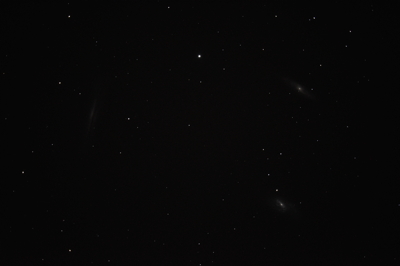
D7000 DSLR (l) vs D7200 DSLR (r): exposure 1 minute, ISO 3200

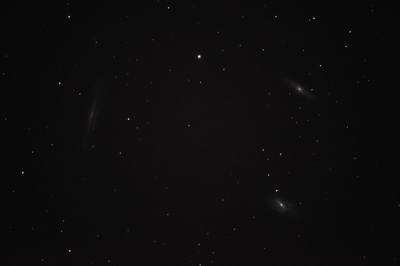
D7000 DSLR (l) vs D7200 DSLR (r): exposure 1 minute, ISO 6400


The D7000 DSLR can do ISO 12800 (Hi 1.0) and ISO 25600 (Hi 2.0). Digital noise dramatically increases with the D7000 at these settings. The D7200 provides these same two ISO settings but as normal values with less noise, as seen in these comparisons:
D7000 DSLR (l) vs D7200 DSLR (r): exposure 1 minute, ISO 12800
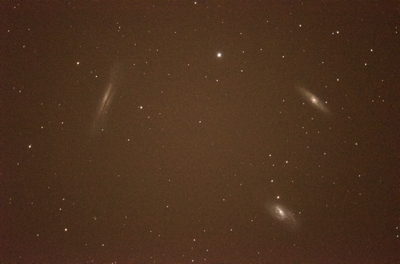

D7000 DSLR (l) vs D7200 DSLR (r): exposure 1 minute, ISO 25600

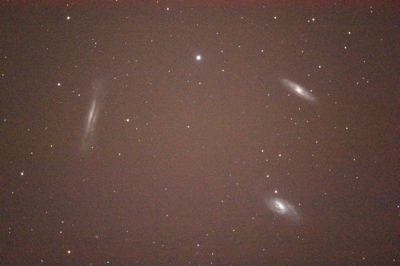
The D7200 DSLR can do ISO 51200 (Hi BW1) and ISO 102400 ("Hi BW2"). The expanded ISO images are Black-and-White only (to reduce digital noise) and are saved as JPEG Fine even if Raw is the normal format.
D7200 DSLR: exposure 1 minute, ISO 51200 (l) vs ISO 102400 (r)


Two things stand out in the above comparisons: the D7000 images are redder and noisier than the D7200 images when using high ISO values. But even at ISO 12800 and 25600 the D7200 DSLR does an amazing job for just a 1 minute exposure. Using ISO 51200 did a pretty good job with minimal noise. The ISO 102400 image looks a little overexposed in the galaxy cores. These very high ISO values should prove useful on very faint objects.
So how does the D7200 do with longer exposures? On 15 April 2015 I did some prime focus + focal reducer imaging of the Leo Triplet. This is a guided 5 minute, ISO 6400, exposure:

I also did a 5 minute, ISO 12800, exposure but the galaxy cores overexposed. Sometimes too much exposure hurts.
I did some handheld sky photography with the D7200 to see how well stars would be imaged at various ISO settings. Here's the results:
Orion, Taurus, Venus, and the Pleiades: exposure f/3.5, 1 second, ISO 6400, FL 18mm

Venus and the Pleiades: exposure f/5.6, 1/10 second, ISO 51200, FL 140mm

Venus and the Pleiades: exposure f/5.6, 1/10 second, ISO 102400, FL 140mm
 Orion Belt and Sword: exposure f/5.6, 1/10 second, ISO 51200, FL 140mm
Orion Belt and Sword: exposure f/5.6, 1/10 second, ISO 51200, FL 140mm

Orion Belt and Sword: exposure f/5.6, 1/10 second, ISO 102400, FL 140mm

This edited handheld photo, f/5, 1/5sec, ISO 25600, FL 66mm, shows Aldebaran and the Hyades at the left, Venus and the Pleiades at the lower right:
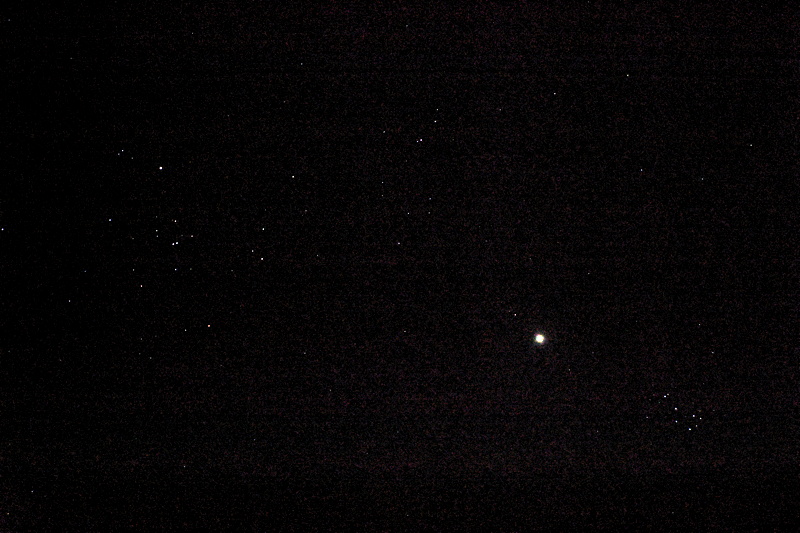
The D7200 DSLR is obviously good for handheld photos using short exposures and shows that you can do sky photography on the spur of the moment without needing a tripod.
I also tested the D7200 DSLR video recording modes for capturing some planets for later image stacking using Keith's Image Stacker. Since having many image frames for stacking is important, I set the D7200 to the 1.3X crop mode to allow 60 frames per second in the highest resolution (1920x1080). (The D7000 only allowed 24 fps at its highest resolution.) The downside to using this high frame rate and highest resolution is that video recording length is limited to 10 minutes. That's not an issue with planet imaging, but could be with imaging long duration events like Jupiter Moons Mutual Events or long passes of the International Space Station. Video duration can be increased to 20 minutes and even 30 minutes by using slower frame rates, lower resolutions, and/or lower quality. With my D7000 I had determined that using the highest resolution worked best for astro video recordings, so I used the highest resolution for my tests with the D7200. I configured the D7200 camera to use the shutter release button to start/stop movie recordings as that setting would allow me to use my Vello Wireless ShutterBoss Timer Remote to start/stop recording without needing to touch the camera. No more image vibrations at the beginning and ending of my astro video recordings which needed to be trimmed off!
Seeing was not good during these video tests. Below is Venus (left), stack of 639 frames (10 seconds), eyepiece projection 444X, exposure 1/60sec ISO 1000, and Jupiter (right), stack of 1839 frames (30 seconds), eyepiece projection 222X, exposure 1/60sec ISO 2500:


I also did a video recording of Jupiter's moon Ganymede using eyepiece projection 222X. This is one frame from a 1920x1080 60fps video, 1/60sec ISO 10000, showing the disk of the moon:

I will be using the 1.3X crop factor and 1920x1080 60fps for my next ISS imaging attempt. I'll discuss that on its report. On 14 April 2015, I used the D7200 DSLR to capture the HST crossing a waning crescent moon:

With my D7000 DSLR I had determined that my photographic limiting magnitude with the 8" LX200-ACF was +17.48. I will be doing a similar exposure at some point with the D7200 to determine a new photographic limiting magnitude. I'll report on that when I've done it.
This review has only covered my initial D7200 DSLR astrophotography. As I do more D7200 astrophotography I will of course be showing the results on my Cassiopeia Observatory reports.
Summary
As you probably expect, the D7200 DSLR is an outstanding camera for general photography. I was able to do some general photography prior to completing this review. I had used my D7000 DSLR a lot during the previous 4.5 years to take photos of people, wildlife, weather, landscapes, and important events, as well as lots of astrophotography. The D7000 was a great upgrade from my D70 DSLR and the D7200 DSLR is already giving me even better photographs.
As for astrophotography with the D7200 DSLR, the preliminary results reported here are impressive, even with using JPEG images. I expect that I'll be using ISO settings greater than 6400 for some faint objects or when long exposures are not appropriate. The quality of the very high ISO values should make imaging easier of these types of objects. The free Nikon Wireless Mobile Utility provides some useful but limited capabilities for astrophotography, but you will still want a remote shutter release for best results.
If you have the Nikon D7100 DSLR, upgrading to the D7200 might be a difficult decision as there are not a lot of new capabilities compared to the D7100. But even with the annoyances mentioned on the first page of this review, if you have the D7000 or an even older Nikon DSLR and use it for astrophotography, upgrading might be an easy decision, especially if you can get a good trade-in deal on your old camera.
Notes: As was previously mentioned, images used in this review were all shot using JPEG Fine Large (6000x4000 pixels) as the D7200 Raw converter had not yet been released for Apple Aperture (or Adobe Lightroom). As Aperture is now a discontinued product I plan to switch to Adobe Lightroom soon for digital photo editing and will eventually use it for astrophotography posted on my Cassiopeia Observatory reports and Photo Albums.
Go back to Page 1 of "Review - Astrophotography with the Nikon D7200 DSLR".
Cassiopeia Observatory Home Page
Copyright ©2015 Michael L. Weasner / mweasner@me.com
URL = http://www.weasner.com/co/Reviews/2015/D7200_DSLR/index2.html
